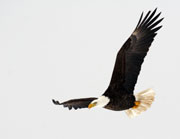8. Hampstead Wharf
Hampstead Wharf Road (off Route 102)

A pleasant summer day watching the cable ferry cross over to Wickham is what you will remember about this little jewel of a getaway. But the memories have just begun as you head out for a birding trek along the abandoned railway line that leads you upriver to the mouth of Little River and Palmer Creek. The rail bed is lined with silver maples, ash trees, and the odd butternut. These beautiful hardwoods are home to a myriad of birds like the Eastern Phoebe, Baltimore Orioles, Tree Swallows, Yellow Warblers, and Common Yellowthroats. You might even encounter a Great Horned Owl whispering away silently after something told you to look up and ahead. Peering through the trees on the riverside reveals a seasonally flooded meadow of bulrushes, cord grass, wild rice and blue flag. During that time of soft light, at the beginning and end of the day, you might hear a Sora Rail calling, or you might be looking skyward for a dive bombing Common Snipe when you hear its quavering, deep and hollow hoots sounding overhead. In the meadow you will probably hear the lonesome quack of a Black Duck, reassuring its brood that mother is keeping tabs on their inquisitive adventures away from the family pack. Travel further up the rail bed and you will look out over the mouths of Palmer Creek and Little River. Here the meadows are wetter, more like an ‘emergent wetland’, an ecologist would say, with enough permanent water to accommodate the large stands of wild rice that are the gourmet tables of Wood Ducks, Blue-winged Teal, American Widgeon, and Mallards. Listen close enough and you might hear the robin-like tone of the widgeon calling while playfully fluttering up and off the water with short clumsy flushes trying to impress everyone.
Guarding the entrance to these waterways are giant silver maples occupied by the opportunistic scoopers of fish, the Osprey and Bald Eagle. The mix of current and tidal influence at the confluence of these two waterways ensures that there are plenty of dorsal-finned dinners for the water raptors. In the expansive meadow upstream water-tolerant maples and ashes try their darndest to extend their occupation out from the intervale and into the wetland, creeping further and further and ever so slowly out along the narrow ridges of soil, the thin tongues of land that the river has rippled up over thousands of years of depositing silt from far away places upriver. In these tree-encircled flooded meadows the waterfowl come to roost at night by the hundreds. Flock after flock of Wood Ducks and Blue-winged Teal, all in an insane rush to get there before the last flicker of daylight. Long after settling in for the night they leap into another frenzy jockying into position as the late arrivals, with their purposeful and direct descent, start to drop out of the sky, floating down into the dark vegetation in ghostly manner. Ah yes, the ever-cautious and mysterious Black Ducks have arrived. All of them now need only to make certain they have a blade or two of wild rice overhead at all times, in order to ward off any attempt by the Great Horned Owl to pick one off while they lay sleeping.